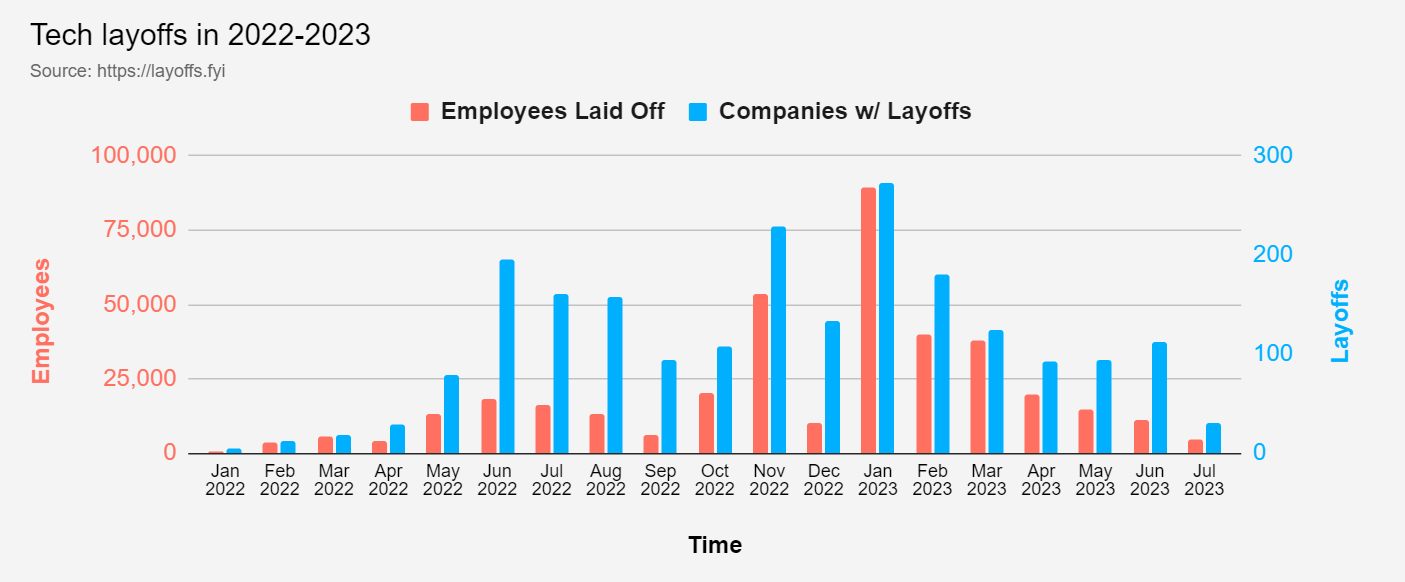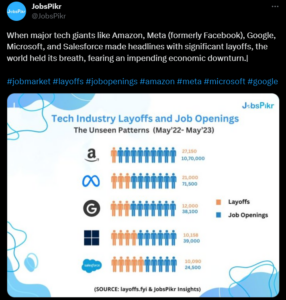
The total layoffs are now greater than all tech company job losses last year.Source: Shutterstock
Biggest tech layoffs in the first half of 2023
- Total layoffs are now greater than all tech company job losses last year.
- Tech giants including Amazon, Meta, Microsoft, Google, IBM, and Salesforce have announced sweeping job cuts.
The tech reckoning from 2022 continued well into this year – and layoffs have been much worse. The main contributing factor to the swath of releases within the technology industry is the hiring binge during the pandemic. During the work-from-home revolution, the tech sector outperformed the rest.
The increased business led to massive hiring campaigns. In fact, at their peak, major firms like Amazon and Meta doubled their headcounts in months. Data compiled by Layoffs. fyi, the online tracker keeping tabs on job losses in the technology sector, indicated that year-to-date, 867 tech companies have laid off about 219,709 staff, compared to 164,411 layoffs in the whole of last year.

Tech layoffs in 2022 to 2023. Source: Layoffs.fyi
Below, Tech Wire Asia has compiled the list of the most substantial-tech layoffs to date.
Tech giant Meta (Facebook)
Earlier this year, Meta became the first big tech company to announce a second round of mass layoffs after showing more than 11,000 employees the door in November 2022. Meta’s chief executive, Mark Zuckerberg, said in March that most of the layoffs in the company’s second round would occur in three “moments” over several months, mainly finishing in May. Some smaller rounds could continue after that, he said.
By the end of the first quarter of this year, the tech giant unveiled plans to lay off another 10,000 workers in a further bid to cut costs. While the first layoffs affected its recruiting team, Meta eventually shrank its technology teams in late April and its business groups by late May. The Facebook owner hopes to streamline its operations by reducing management layers and asking some leaders to take on work previously reserved for the rank and file.
The cuts brought the company’s headcount down to where it stood as of about mid-2021, following a hiring spree that doubled its workforce since 2020.
Alphabet
“We’ve decided to reduce our workforce by approximately 12,000 roles,” Sundar Pichai, CEO of Google and Alphabet, said in January. Little did we know that’d be the first of many this year. The move to lay off 6% of its global workforce impacted divisions such as Area 120, the Google in-house incubator, and Alphabet’s robotics division, Intrinsic.
Pichai wasn’t shy about the reasoning: Alphabet had been hiring for a “different economic reality” and was restructuring to focus on the internet giant’s most influential businesses. The decision hit the company’s Area 120 incubator particularly hard, with most of the unit’s workers losing their jobs.
Sub-brands like Intrinsic (robotics) and Verily (health) also shed significant portions of their workforce in the days before the mass layoffs. Waymo, the autonomous vehicle unit of Alphabet, has conducted two rounds of layoffs that shed 209 people, or eight percent of its force.
Microsoft
For Microsoft, it started its second-largest wave of layoffs in company history when it signaled it would cut 10,000 jobs between mid-January and the end of March. As with other tech giants, it was trimming costs as customers scaled back their spending in the post-pandemic recovery period.
Some divisions felt it was more challenging — Microsoft reportedly gutted the HoloLens and mixed reality teams, while 343 Industries is believed to be rebooting Halo development after losing dozens of workers. GitHub, too, slashed 10% of its team, or roughly 300 people. Early last week, the software giant confirmed that it’s eliminating additional jobs, a week after the start of its 2024 fiscal year.
Microsoft filed a notice saying it would cut 276 people in its home state of Washington. Of those, 66 are virtual. To recall, before its move to cut 10,000 jobs in January this year, the giant saw its most extensive layoffs in 2014 following Nokia’s misguided acquisition. The number of jobs the company cut over two years was 18,000.
Amazon
The tech and e-commerce giant recently wrapped up the most extensive layoffs in its 29-year history. Amazon laid off 18,000 employees over several months between last year, November, and earlier this year, most coming from retail and recruiting teams. The tech giant then announced an additional 9,000 layoffs in March and over 100 gaming employees in April.
Amazon CEO Andy Jassy has been aggressively slashing costs across the company as the e-retailer reckons with an economic downturn and slowing revenue growth. To no one’s surprise, Jassy blamed an “uncertain economy” and rapid hiring in recent years.
Jassy also targeted some of Amazon’s more unproven bets, such as grocery and devices, while freezing corporate hiring and slowing warehouse expansion.
IBM
Although since the pandemic most tech giants have been laying off staff due to corporate strategy shifts, for IBM, it is financial hardship. The computing giant axed 1.5% of its workforce in late January after offloading both its AI-driven Watson Health business and its infrastructure management division (now Kyndryl) in the fall.
Online data shows that IBM currently employs about 260,000 workers and continues to hire for software development and customer-facing roles. However, the company’s CEO, Arvind Krishna, also iterated in May that the company expects to pause hiring for positions it thinks could be replaced with artificial intelligence in the coming years. In an interview with Bloomberg, Krishna said that hiring in back-office functions — such as human resources — will be suspended or slowed.
Those non-customer-facing roles amount to roughly 26,000 workers, Krishna said. “I could easily see 30% of that getting replaced by AI and automation over five years.” Krishna shared that finding talent is easier today than a year ago. Although the layoffs at IBM earlier this year amounted to about 5,000 workers once completed, Krishna said IBM has added to its workforce overall, bringing on nearly 7,000 people in the first quarter.

Tech layoffs vs openings. Source: Twitter
Salesforce
It was just four days into the new year when Salesforce set the tone for the year with a warning that it would lay off 8,000 employees, or about 10 percent of its workforce. The problem? Over hiring as well. While the cloud software brand thrived during the pandemic with rapidly growing revenue, it admitted that it hired too aggressively during the boom and couldn’t maintain that staffing level while the economy was declining.
There are, however, talks that, like tech giants Meta and Amazon, Salesforce may go for a second round of layoffs too. According to a Bloomberg report, Salesforce may go for another round of job cuts as the company seeks to focus more on profitability.
“The structure of the organization — if we feel like it needs to change and reshape — we’re going to make those moves to drive the efficiencies,” the report quoted Millham in an interview.
Shopify’s 20% trimming of the workforce
After a reduction of 10% announced last July, Shopify laid off 20% of its global workforce in May this year— its second sizable employee culling. According to regulatory filings, at the end of its last fiscal year, Shopify had 11,600 employees, so the 20% reduction announced two months ago amounts to more than 2,300 people.
The Canadian company is scaling back now that the pandemic rush is over, so it even sold its logistics business to Flexport. Founder Tobi Lütke characterized the job cuts as necessary to “pay unshared attention” to Shopify’s core mission and an acknowledgment that the firm needed to be more efficient now that the “stable economic boom times” were over.
Other notable tech layoffs
Zoom – 1300 employees after CEO Eric Yuan stated the company didn’t hire “sustainably” as it dealt with its sudden success.
Dell – A total of 6650 employees after a computer shipments 37% in the fourth quarter of 2022.
Yahoo – 20% of the workforce or about 1600 employees throughout 2023.
PayPal – 2000 employees of 7% of its workforce in January 2023.
SAP – 2800 employees after the company reported a 68% drop in profit in the end of 2022.
Twitter – 3700 employees since Elon Musk took over.
Interestingly, despite the numerous tech layoffs, the demand for tech jobs have also been increasing, especially for roles in non-tech companies that have increased their tech adoption.
READ MORE
- Next-gen CX is based on customer communication management systems.
- Enhancing Business Agility with SASE: Insights for CIOs in APAC
- 3 Steps to Successfully Automate Copilot for Microsoft 365 Implementation
- Trustworthy AI – the Promise of Enterprise-Friendly Generative Machine Learning with Dell and NVIDIA
- Strategies for Democratizing GenAI


